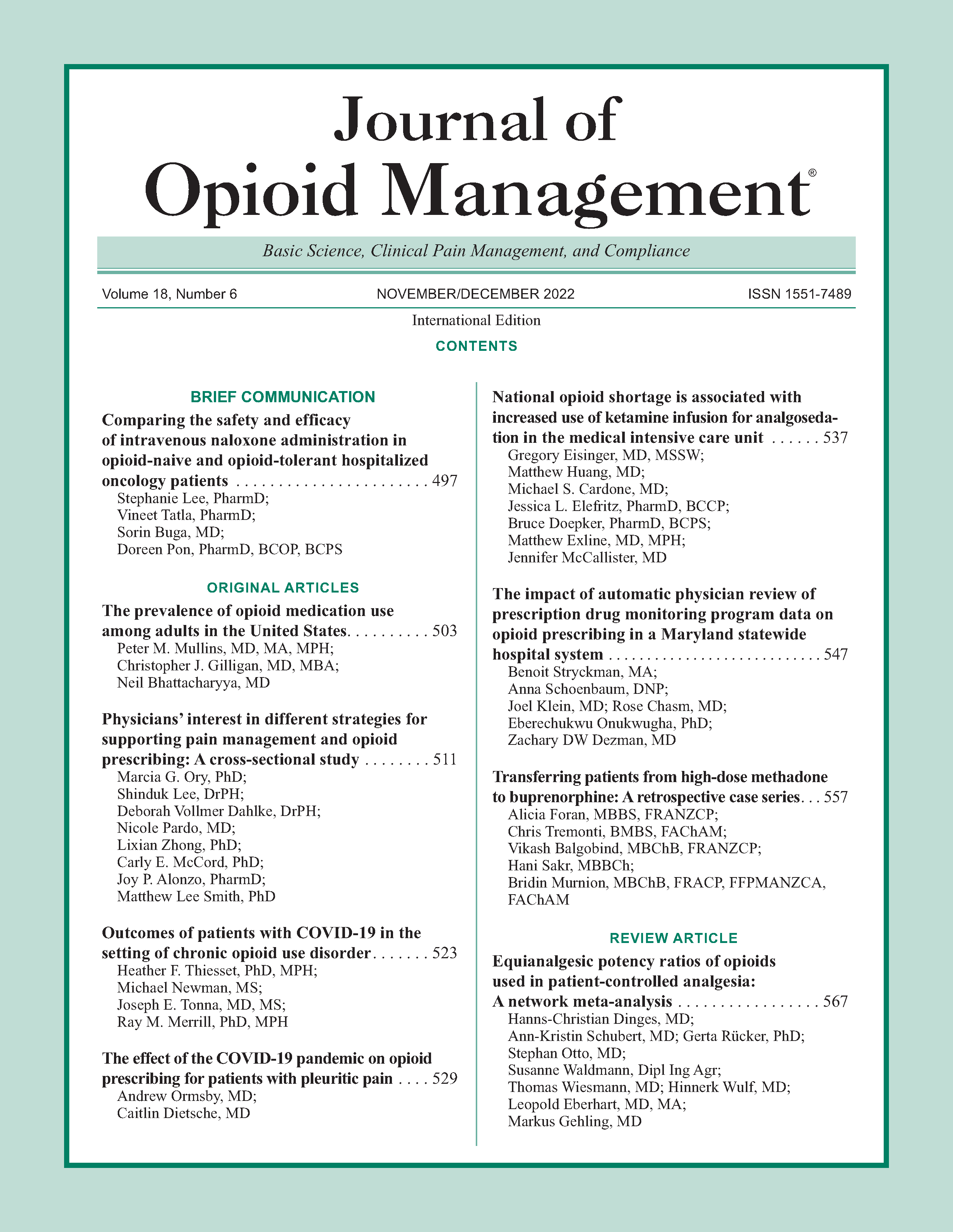Outcomes of patients with COVID-19 in the setting of chronic opioid use disorder
DOI:
https://doi.org/10.5055/jom.2022.0747Keywords:
COVID-19, opioid use disorder, substance abuseAbstract
Background: There are limited studies regarding the effects of COVID-19 in patients with a concurrent diagnosis of opioid use disorder (OUD). Due to the rapidly developing nature and consequences of this disease, it is important to identify patients at an increased risk for serious illness. The aim of this study was to identify whether COVID-19 patients with OUD are at an increased risk of hospitalization and other adverse outcomes.
Methods: This retrospective chart review compared clinical parameters from patients with positive COVID-19 status as identified by a positive SARS-CoV-2 PCR test and diagnosed OUD at the University of Utah Health. The primary outcome variables were hospitalization for COVID-19, length of hospital stay, and the presence of comorbidities in the OUD patient population. Descriptive statistics and prevalence ratios (PRs) were generated. Log binomial models generated PRs adjusted by age, sex, and race, and comorbidities of asthma, pneumonia, hypertension, cardiovascular disease, and diabetes.
Results: COVID-19 patients with OUD were significantly more likely than patients without OUD to have asthma (p < 0.01), diabetes (p < 0.01), hypertension (p < 0.01), cardiovascular disease (p < 0.01), and chronic pneumonia (p < 0.01), and to be hospitalized (27.9 percent vs 3.6 percent; p < 0.01), admitted to the intensive care unit (11.5 percent vs 1.5 percent; p < 0.01), and receive mechanical ventilation (30.5 percent vs 0.1 percent; p < 0.01). After adjusting for age, sex, race, asthma, pneumonia, cardiovascular disease, hypertension, and diabetes, patients with OUD continued to be at increased risk for inpatient hospitalization (aPR = 4.27, 95 percent confidence interval [CI] = 1.66-10.94). Patients with OUD also averaged longer stays in the hospital than those without OUD (9.53 days vs 0.70 days, p < 0.001).
Conclusion: Patients with a diagnosis of OUD in the presence of COVID-19 are more likely to be hospitalized, have underlying health issues, and have longer hospital inpatient stays compared to patients without OUD.
References
Ellington SS, Strid P, Tong VT, et al.: Characteristics of women of reproductive age with laboratory-confirmed SARS-CoV-2 infection by pregnancy status. MMWR Morb Mortal Wkly Rep. 2020; 69: 769-775.
Feng He YD, Weina L: Coronavirus disease 2019: What we know? J Med Virol. 2020; 92(7): 719-725.
Yan Y, Shin WI, Pang YX, et al.: The first 75 days of novel coronavirus (SARS-CoV-2) outbreak: Recent advances, prevention, and treatment. Int J Environ Res Public Health. 2020; 17(7): 2323.
Du Y, Tu L, Zhu P, et al.: Clinical features of 85 fatal cases of COVID-19 from Wuhan. A retrospective observational study. Am J Respir Crit Care Med. 2020; 201(11): 1372-1379.
Dennison Himmelfarb CR, Baptiste D: Coronavirus disease (COVID-19): Implications for cardiovascular and socially at-risk populations. J Cardiovasc Nurs. 2020; 35(4): 318-321.
Hategan A, Abdurrahman M: Hidden in plain sight: Addressing the unique needs of high-risk psychiatric populations during the COVID-19 pandemic. Psychiatry Clin Neurosci. 2020; 74: 439-1111.
Williams JR, Cole V, Girdler S, et al.: Exploring stress, cognitive, and affective mechanisms of the relationship between interpersonal trauma and opioid misuse. PLoS One. 2020; 15(5): e0233185.
Canan CE, Chander G, Monroe AK, et al.: High-risk prescription opioid use among people living with HIV. J Acquir Immune Defic Syndr. 2018; 78(3): 283-290.
National Institute on Drug Abuse: Overdose death rates. Available at https://www.drugabuse.gov/related-topics/trendsstatistics/overdose-death-rates. Accessed January 19, 2019.
Han Y, Yan W, Zheng Y, et al.: The rising crisis of illicit fentanyl use, overdose, and potential therapeutic strategies. Transl Psychiatry. 2019; 9(1): 282-282.
Slavova S, Rock P, Bush HM, et al.: Signal of increased opioid overdose during COVID-19 from emergency medical services data. Drug Alcohol Dependence. 2020; 214: 108176-108176.
Prevention CfDCa: COVID-19 questions and answers: For people who use drugs or have substance use disorder. Available at https://www.cdc.gov/coronavirus/2019-ncov/need-extraprecautions/other-at-risk-populations/people-who-use-drugs/QA.html. Accessed February 22, 2021.
Allen B, El Shahawy O, Rogers ES, et al.: Association of substance use disorders and drug overdose with adverse COVID-19 outcomes in New York City. J Public Health (Oxford, England). 2020; 43: 462-465.
Wang QQ, Kaelber DC, Xu R, et al.: Correction: COVID- 19 risk and outcomes in patients with substance use disorders: Analyses from electronic health records in the United States. Mol Psychiatry. 2021; 26(1): 40-40.
Wang QQ, Kaelber DC, Xu R, et al.: COVID-19 risk and outcomes in patients with substance use disorders: Analyses from electronic health records in the United States. Mol Psychiatry. 2021; 26(1): 30-39.
Prevention CfDCa: COVID-19 and people at increased risk. Available at https://www.cdc.gov/drugoverdose/resources/coviddrugs-QA.html#anchor_1618943019408. Accessed July 22, 2021.
Tamhane AR, Westfall AO, Burkholder GA, et al.: Prevalence odds ratio versus prevalence ratio: choice comes with consequences. Statist Med. 2016; 35(30): 5730-5735.
Ziersch A, Due C: A mixed methods systematic review of studies examining the relationship between housing and health for people from refugee and asylum seeking backgrounds. Soc Sci Med. 2018; 213: 199-219.
Zhang YS, Strauss JA, Hu P, et al.: Links between mortality and socioeconomic characteristics, disease burden, and biological and physical functioning in the aging Chinese population. J Gerontol B. 2021.
Newacheck PW, Halfon N: Preventive care use by school-aged children: Differences by socioeconomic status. Pediatrics. 1988; 82(3): 462-468.
Huskamp HA, Busch AB, Souza J, et al.: How is telemedicine being used in opioid and other substance use disorder treatment? Health Affairs. 2018; 37(12): 1940-1947.
Thiesset HF, Schliep KC, Stokes SM, et al.: Opioid misuse and dependence screening practices prior to surgery. J Surg Res. 2020; 252: 200-205.
Published
How to Cite
Issue
Section
License
Copyright 2005-2025, Weston Medical Publishing, LLC and Journal of Opioid Management. All Rights Reserved.











